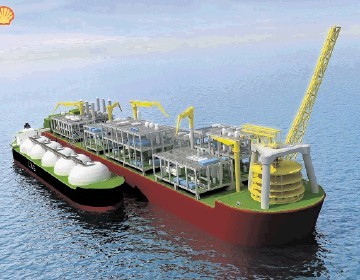
A decade or so ago, liquefied natural gas was fast becoming the big strategic play in the natural gas industry. It had the potential to make big money in a world of shrinking energy resources and mounting environmental pressure to cut dependency on coal for firing power stations, especially among OECD nations.
The rush for LNG spawned a rash of project proposals . . . field developments and process trains, plus specialist tankers and import terminals, particularly in Europe, US and Asia-Pacific, notably Japan and China.
About five years ago, I was involved in research into the various European projects mooted and the number was surprisingly large to the point of possible overkill though I believe that some fell victim to the credit crunch of 2008 and the economic difficulties that have dogged the EU and US.
Fast frame to a couple of years ago when shale gas hit the headlines in a big way, especially with regard to rocketing US production and mounting concerns in the EU about the impact of reservoir fracking on water resources, and it is likely that few people questioned or even wondered much about the possible impact on LNG which so far has been based on conventional natural gas resources as opposed to unconventional such as shale.
That said, there has been talk about the US becoming a net exporter of gas, thanks to the huge and success of the shale business. Moreover, the conversation has even turned to liquefaction of surplus production and exporting it as LNG.
Talk about turning the tables. This must surely be pressuring LNG markets.
For sure the shale bonanza has had a major US domestic impact . . . there is so much gas available that prices have dropped to their lowest for a decade. Great for US consumers; not so good for producers.
If this can happen Stateside, it can surely happen elsewhere. Europe? China? Other places?
And if that is the case, will it not derail LNG as we know it? Given the speed with which shale gas roared into the headlines following many years of quiet exploitation by a bunch of small companies, I’ll warrant that changes elsewhere could be even more profound.
And the biggest joker in the pack for LNG is surely China.
There has been much speculation lately regarding the Chinese position and the fact that only a few wells have been drilled so far. I’ve read analyst material that downplays the pace at which domestic unconventionals could come to the fore in the world’s most populous nation, moreover one that many had assumed was hydrocarbons deficient with one exception . . . coal.
But get this.
According to the US Energy Information Administration, China may possess as much as 1.275quadrillion cu.ft of “technically recoverable” shale gas. Compare this with the American position . . . 862trillion cu.ft.
It is said that China has enough gas to fuel her economy for the next 300 years based on current consumption levels.
The Chinese are the third largest consumer of natural gas fter the US and Russia and their goal is for gas to account for 10% of energy supply by 2020. That’s just eight years away.
The Chinese are keen to reduce their dependency on imported oil and gas and are very keen to develop their own resources. The targets are to increase oil and gas output by 23% by 2015 to 360million tonnes equivalent and to 450million tonnes by 2030.
The shale gas component is impressive. The plan is to produce 229.5billion cu.ft of the resource by 2015 and a staggering 2.82trillion cu.ft by 2020.
It is not long since China National Offshore Oil Corp (CNOOC) started up its first shale gas project in-country.
Now, it has been reported by Bloomberg that Neil Beveridge, an energy analyst at Sanford C. Bernstein & Co reckons that: “It may take more than five years for CNOOC to turn this exploration into real production”.
However, I think Beveridge and others will be taken by surprise. We in the West have a habit of underestimating the ability of the Chinese to set what we might think are unattainable targets. It seems to me that they beat them more often than not.
China’s plan is to have 990 shale gas wells drilled by 2015 . . . from an almost standing start.
To get to where China wants to be will require a huge number of land rigs that are designed and built or suitably modified for the purpose, then there’s all the other hardware to design and manufacture or buy off someone else’s shelf . . . I’m particularly thinking of the Americans and Canadians.
Chinese companies are out there buying into the technical expertise they need. Consider Sinopec’s acquisition of one-third of Devon Energy for $900million in cash. Indeed, Chinese firms spent over $18billion last year, buying oil and gas companies around the world.
And there will be ample room for companies like BP, Chevron and Shell to get in on the Chinese shale klondike. Indeed they’re already involved.
So where does this leave LNG imports?
Well, last month, Oslo-based analyst Erik Nikolai Stavseth said in a market note that Chinese imports of liquefied natural gas will rise 42% this year. The world’s largest energy consumer will import 17million tonnes of LNG in 2012, up from 12million tonnes last year.
His prediction will likely be somewhere near correct, but will such meteoric leaps in LNG demand quickly become a short-lived blip. You can be sure that the Chinese will seek to reduce and even eliminate such imports as soon as is possible. Just think of the US and the transformational role of shale gas in just a few short years.
Then whither “conventional” LNG?
Recommended for you
